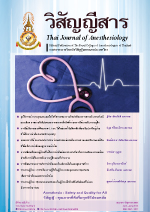Low dose intrathecal morphine (0.1mg) for post-operative analgesia in patients with hemiarthroplasty: A randomized double-blind controlled clinical trial
Main Article Content
Abstract
Introduction: Spinal anesthesia (SPA) including intrathecal morphine is frequently used for surgical treatment of fracture of the femur. However, intrathecal morphine is accompanied by side effects, such as sedation, nausea and vomiting. To identify efficiency of low dose intrathecal morphine (0.1 mg) for postoperative analgesia in hip hemiarthroplasty. Methods: Patients with femoral neck fracture scheduled for hemiarthroplasty received either SPA with 3-3.5 ml of 0.5% bupivacaine alone (Control, C-gr, n = 23) or with additional 0.1 mg intrathecal morphine (ITM-gr, n = 24). Therapeutic effects and side effects were recorded until 48 hours postoperatively. Results: The two groups were comparable, regarding biometric data as well as operation characteristics. Compared to control group patients, intrathecal morphine patients had lower pain scores at any time and were more pleased with postoperative pain treatment. Additionally, morphine consumption in these patients was less and time interval to rescue medication significantly longer. Side effects such as nausea, vomiting and pruritus were no significant difference between the two groups. Conclusion: Low dose intrathecal morphine (0.1mg) provided good postoperative analgesia with acceptable side effects. Higher dose of intrathecal morphine in this operation was not necessary.
Article Details
Section
Original articles


